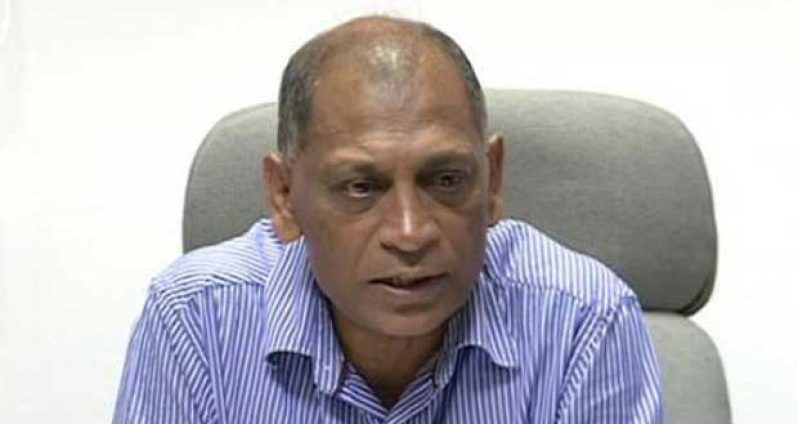GUYANA’s rice production in the final crop this year has brought the total in 2014 to a record-breaking 633,000 tonnes for 2014.And according to Agriculture Minister, Dr. Leslie Ramsammy, at a press briefing yesterday, a small percentage of rice acreage is still to be harvested.
The production in the final crop this year surpassed the first crop, which recorded just over 300,000 tonnes.
The production for 2013 was 535,212 tonnes, which was far above the original target of 413,000 tonnes, and reflected a 27 per cent increase over the production in 2012. The average production per hectare was some five tonnes.
EXPORTS AT ALL-TIME HIGH
Asked about exports to date, Dr. Ramsammy disclosed that some 481,000 tonnes of rice has been exported already, with additional shipments to be made before the end of the year.

“We are likely to exceed the 500,000 tonnes export mark,” he said, adding that revenues for export of rice are in excess of US$250M.
Exports for 2014 are pegged at an all-time high, with several new trade agreements inked this year.
Guyana currently has export agreements with several countries in the Caribbean, Venezuela and Panama, among others. Also, arrangements for rice shipments to countries in West Africa are still being finalised.
The export mark of 400,000 tonnes was surpassed in mid-October, excluding a number of contracts for rice exports that still had to be met. The 500,000 tonnes of rice was the 2020 target for production but in 2011, for the first time, the 400,000-tonne mark was passed and repeated in 2012 and 2013.
The export in 2013 was 394,000 tonnes, from a production of 535,212 tonnes, which was far above the original target of 413,000 tonnes. It is expected that exports will soon overcome the barrier which will bring Guyana in line with the world’s largest producers of rice. As such, focus is being placed on exploring new and emerging global markets, tackling the crucial and critical issues to facilitate increasing production.
MEETING WITH MILLERS
The Agriculture Minister also stated that paddy sales for the year have totaled some $45B.
He added that a meeting with rice millers is scheduled for this week to ensure that all farmers are paid in full.
According to him, some $42B has been paid out for the year, with $3.2B in payments still to be made.
Dr. Ramsammy acknowledged that while looking at the big picture, the sums paid out to date are “huge” sums, for the small farmers the outstanding monies are also significant.
On that note, he assured that all efforts will be made to ensure that farmers are paid their full amounts.
SOWING UNDERWAY
Meanwhile, head of the Guyana Rice Producers’ Association (RPA), Dharamkumar Seeraj, told the Guyana Chronicle that sowing for the first crop of 2015 is progressing well, with some 60 per cent of rice acreage in Guyana already cultivated.
He noted that most of the rice lands are expected to be under cultivation by the end of the year, some 90 per cent of the lands.
However, Seeraj admitted that there are minor challenges in Region 6 (East Berbice/Corentyne) relative to irrigation.
“The weather is dry in Region 6 and that is proving to be a challenge because Region 6 has no conservancy. Farmers there depend on water being channelled from the Canje River,” he said.
According to him, steps are being taken to address this issue. “We are looking at boosting pumping capacity, as well as ensuring that there is not wastage of water,” he said.
Seeraj stated too that similar problems exist in Regions 3, 4 and 5, but to a lesser extent, given that there has been some amount of rainfall in those rice producing regions. “The hardest hit region by far is Region 6,” he said.
Seeraj contends that 2015 is expected to be another record-breaking year for the industry.
Rice production was at its lowest in Guyana in the late 1980s, due to neglect of the industry which saw a lack of sound agricultural policies and programmes, and little or no investment in agricultural infrastructure and research and training. Today, there are greater investments in agriculture infrastructure, education and training of farmers, research, and more guaranteed markets as well.
Secure drainage, new and improved farming technologies and new rice varieties are among some of the interventions over the years, on the part of Government that have been fuelling the rice industry’s growth. Government has also moved to secure several markets for rice farmers, the largest being with Venezuela.
Government, cognisant of maintaining the strong performance of the rice industry, has set aside in Budget 2014 the sum of $500M to help maintain its competitiveness. The industry will also benefit from this year’s investment in drainage and irrigation. (Vanessa Narine)




.png)









